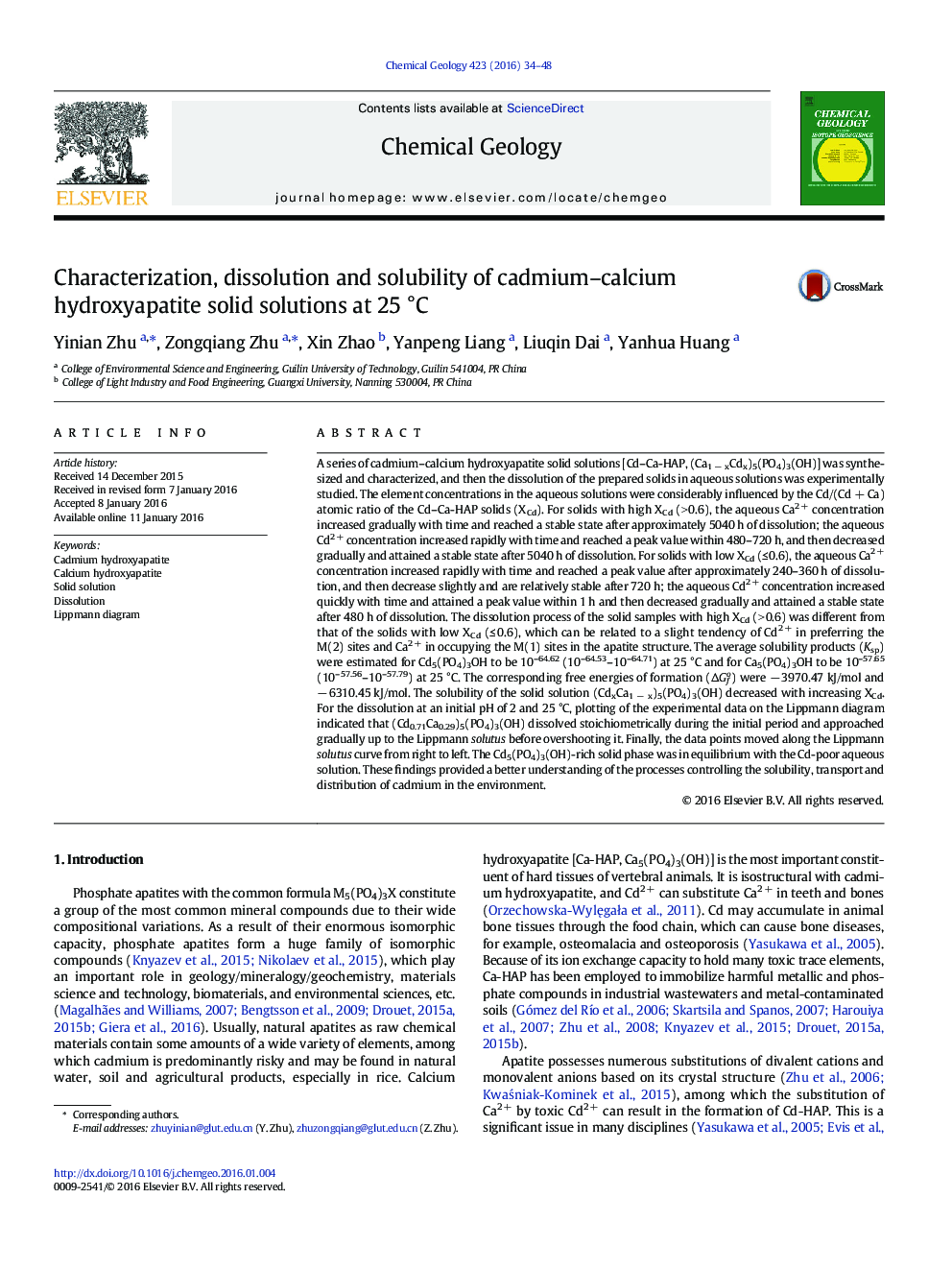| کد مقاله | کد نشریه | سال انتشار | مقاله انگلیسی | نسخه تمام متن |
|---|---|---|---|---|
| 4698318 | 1637551 | 2016 | 15 صفحه PDF | دانلود رایگان |

• The solubility products are 10–64.62 for Cd5(PO4)3OH and 10–57.65 for Ca5(PO4)3OH.
• The ΔGfo are − 3970.47 kJ/mol for Cd5(PO4)3OH and − 6310.45 kJ/mol for Ca5(PO4)3OH.
• The solubility of (CdxCa1 − x)5(PO4)3(OH) decreases with increasing x.
• The dissolution process of the x > 0.6 solid differs from that of the x ≤ 0.6 solid.
• The Cd5(PO4)3(OH)-rich solid is in equilibrium with the Cd-poor aqueous solution.
A series of cadmium–calcium hydroxyapatite solid solutions [Cd–Ca-HAP, (Ca1 − xCdx)5(PO4)3(OH)] was synthesized and characterized, and then the dissolution of the prepared solids in aqueous solutions was experimentally studied. The element concentrations in the aqueous solutions were considerably influenced by the Cd/(Cd + Ca) atomic ratio of the Cd–Ca-HAP solids (XCd). For solids with high XCd (> 0.6), the aqueous Ca2 + concentration increased gradually with time and reached a stable state after approximately 5040 h of dissolution; the aqueous Cd2 + concentration increased rapidly with time and reached a peak value within 480–720 h, and then decreased gradually and attained a stable state after 5040 h of dissolution. For solids with low XCd (≤ 0.6), the aqueous Ca2 + concentration increased rapidly with time and reached a peak value after approximately 240–360 h of dissolution, and then decrease slightly and are relatively stable after 720 h; the aqueous Cd2 + concentration increased quickly with time and attained a peak value within 1 h and then decreased gradually and attained a stable state after 480 h of dissolution. The dissolution process of the solid samples with high XCd (> 0.6) was different from that of the solids with low XCd (≤ 0.6), which can be related to a slight tendency of Cd2 + in preferring the M(2) sites and Ca2 + in occupying the M(1) sites in the apatite structure. The average solubility products (Ksp) were estimated for Cd5(PO4)3OH to be 10–64.62 (10–64.53–10–64.71) at 25 °C and for Ca5(PO4)3OH to be 10–57.65 (10–57.56–10–57.79) at 25 °C. The corresponding free energies of formation (ΔGfo) were − 3970.47 kJ/mol and − 6310.45 kJ/mol. The solubility of the solid solution (CdxCa1 − x)5(PO4)3(OH) decreased with increasing XCd. For the dissolution at an initial pH of 2 and 25 °C, plotting of the experimental data on the Lippmann diagram indicated that (Cd0.71Ca0.29)5(PO4)3(OH) dissolved stoichiometrically during the initial period and approached gradually up to the Lippmann solutus before overshooting it. Finally, the data points moved along the Lippmann solutus curve from right to left. The Cd5(PO4)3(OH)-rich solid phase was in equilibrium with the Cd-poor aqueous solution. These findings provided a better understanding of the processes controlling the solubility, transport and distribution of cadmium in the environment.
Journal: Chemical Geology - Volume 423, 20 March 2016, Pages 34–48